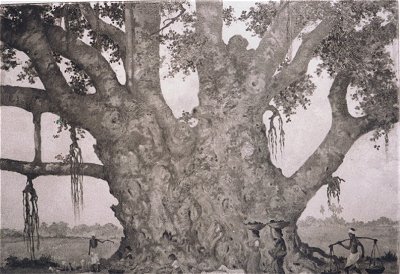Ashwatha: Tree of Life
by Jyotsna Kamat
First Online: May 29, 2003
Page Last Updated: December 07, 2024
Sage Shankaracharya interprets this tree as representing the the entire cosmos. 'Shwa' in Sanskrit means tomorrow. 'a' indicates negation, and 'tha' means one that stands or remains. He interprets Ashwatha to indicate "One which does not remain the same tomorrow", or the universe itself.
This Ashwatha tree is quite remarkable because it grows both upwards as well as top to bottom. The branches themselves morph into roots, so even if the original tree decays and perishes, its branches underneath are young and continue to enclose the parent. This eternal life of the the Peepal tree has inspired many Indian philosophers and Hindu thought. It is not uncommon to run into Ashwatha tree that is few hundreds or even a thousand years old!
© K. L. Kamat

Ashwatha Tree
Painting by artist Shuddhodhana, Mysore
Besides harboring thousands of birds, insects, and providing shade to animals and humans, its foliage is very rich in protein and the bark of the tree is used in several native medicinal drugs. There was a time in India when a Peepal tree was planted in the premises of every temple, and was regarded as the Tree of Life.
K.L. Kamat/Kamat's Potpourri
Worshipping of Ashwatha Tree
Detail from an Indian painting
![]()

